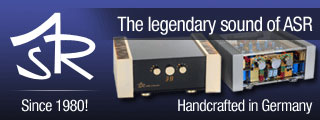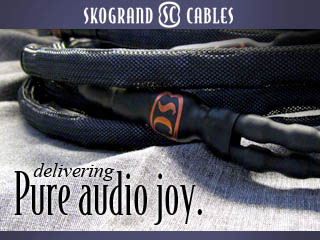With Sonos streaming audio and file playback
As expected, since the Synchro-Mesh was designed to integrate with the Sonos Digital Music System, the results were uniformly positive with streaming audio and file playback. Just as an outboard DAC enhances Sonos’ performance, so also the Synchro-Mesh elevates its sound in totality. Sonos is a weak HiFi source and it plumps up nicely when the Synchro-Mesh puts all the bits in their proper place. Most users of Redbook discs have by now heard a demonstration, or have switched entirely to 24 bit/192 kHz playback for CD. Interpolation of data points smoothes the roughness of 16 bit/44 kHz playback. Similarly, the synchronization of the data stream causes lower grade sources like Sonos to sound silkier.
Getting the timing right is not, however, an alternative to good old fashioned superior build quality. The Synchro-Mesh was of minimal value as an add-on to the formidable Moon 750D Player. My conclusion is that when using a 32-bit DAC such as the EE Minimax DAC Plus or the Moon 750D, the Synchro-Mesh is not what I would consider a sonically necessary upgrade. However, I am confident that with the older 24/192 players like the NAD, or with streaming playback such as the Sonos provides, the Synchro-Mesh is a smart and cost effective means of upgrading. In other words, the Synchro-Mesh was not a “fixer” for 32-bit DACs, but was for 24-bit DACs.
Back to the beginning
This returns us to our original question; which playback is “better,” that is, truer to the source? According to my ears, if absolute definition and clarity were the primary criteria by which proper clocking, or elimination of transport-induced jitter, had occurred, then I am forced to say that devices with the Sabre 32-bit Reference DAC Chips make reclocking superfluous. However, if one judges superior digital sound predominantly by tonality and warmth, then the Synchro-Mesh brought this to whatever source it was applied and would be deemed efficacious. This should not be considered failure for Steve and the Synchro-Mesh, as I recall seeing online one conversation in which Steve stated that if a device effectively eliminated jitter, adding a Synchro-Mesh would worsen the sound. An analogue-oriented listener might conclude that the Synchro-Mesh is indeed a great product for all digital sources. I believe owners of Sonos and streaming audio devices would find the effect most pleasing; it may even stave off the temptation to upgrade one’s DAC.
A while back I wrote up the Van Alstine UltraDAC. I will not soon forget the cordial but conflicting perspectives that Frank and I shared regarding the efficacy of aftermarket power cords, in particular with the UltraDAC. I suggested to Frank that upgraded power cables would make a significant influence for his gear and that he utilize detachable IEC sockets in his components. His response was to the effect that which power cord used is as important as the polish used on the rails of the Titanic! I have to admit, it was a funny line, even if I utterly disagreed.
Months later, Frank visited my home to allow me a listen to his FET Valve amp. I did not miss the opportunity to demonstrate the efficacy of power cords. When he heard the difference he did not go on at length that evening, as he had spent a dreadfully long day on the road. But at the next show when I saw him he smirked and called me over to investigate his latest amp – the FET Valve – which happened to have an IEC socket! Good move, Frank!
So, when Steve from Empirical Audio enthuses, “You can spend $15K on a transport with decent jitter characteristics, or you can buy an Oppo and a Synchro-Mesh and get a similar result,” I think I need to invite Steve to my home! Will both likely get you a “de-jittered” sound? Sure. Will both sound similar? Not in my experience. Here is the rub; jettisoning jitter may be effective but it is not critical. (Or necessary but not efficient? -Exec. Ed.) If it were critical, then you could get the same result with a NAD and Synchro-Mesh as with a Moon 750D. I wish it were that easy, and cheap!
However, I believe Steve is right when he suggests that mating a Synchro-Mesh with a less expensive DAC may allow one to avoid spending $7K on a DAC. So, I will split the difference with Steve, retaining my demand for a higher quality transport while agreeing that the Synchro-Mesh and a $1-1.5K DAC can achieve very lofty performance. We both agree that a shorter, perhaps 1.25 to 1.5M digital link is preferable.
Alas, there is no simple solution to obtaining optimum digital sound. In my experience neither transport, server, DAC nor reclocker is to credit for being the “fixer.” Digital continues to be a “jittery slope,” as regards ideal setup of a system. One way to smooth that jagged slope for less than state-of-the-art rigs is the employment of the Synchro-Mesh.
Associated Components:
- Source: Simaudio Moon Evolution 750D DAC/Player; Cambridge Audio 840C; Denon 2900 Universal Player; Sonos Digital Music System; Oppo DV-970HD
- NAS: Buffalo Linkstation 500G
- DAC: Eastern Electric Minimax DAC Plus with Burson and Dexa NewClassD Discrete Opamp Upgrade
- Preamp: VAC Renaissance Signature Preamplifier MkII; Purity Audio Design Silver Statement; Cambridge Audio 840E
- Amps: VAC Phi 200; Pass Labs XA160.5 Monoblocks; Jones Audio PA-M300 Monoblocks; Cambrige Audio Azur 840W
- Integrated: Pathos Classic One MkIII stereo tube hybrid (two units bridged to mono); Peachtree Audio Nova
- Speakers: King’s Audio Kingsound King; Kings Audio Kingsound King II; Legacy Audio Whisper DSW “Clarity Edition”; Kings Audio King Tower Omnidirectional; Daedalus Audio Ulysses; Eminent Technology LFT-8b
- Subwoofers: Daedalus Audio BOW
- IC’s: Clarity Cable Organic RCA/XLR; Tara Labs RSC Air1 series 2; Wireworld Equinox; Wireworld Silver Eclipse; Wireworld Platinum Eclipse
- Speaker Cables: Clarity Cable Organic Speaker; Tara Labs RSC Air1; Wireworld Equinox 5; Wireworld Silver Eclipse
- Digital Cables: Clarity Cable Organic Digital; Tara Labs RSC Air 75; Wire World Startlight 6; Wireworld Gold Starlight 5, Wireworld Gold Starlight 6
- Power Cables: Clarity Cable Vortex; MIT Oracle ZIII; Tara Labs RSC Air; Xindak PF-Gold; Wireworld Stratus 5, Electra 5 and Silver Electra
- Power Conditioning: Wireworld Matrix Power Cord Extender; Tara Labs ISM Power Screen; Tice Audio Solo
- ← Previous page
- (Page 3 of 3)



I’ve always been curious about the product, but you didn’t, or at least explicitly, mention if you’re using upsampling with the Synchro-Mesh. I assume your sources are redbook and have the 96KHz version of SM (there’s a 44K version I think)? I remember reading in forums where Steve Nugent stated that SM’s upsampling is quite good but not ideal. So, it’s possible that the degradation of sound you heard is due to upsampling and not due to whether it’s more or less jitter. If the degradation of sound is due to anything jitter related, that’s a negative review for BOTH ESS Sabre and SynchroMesh, since this shows the ESS Sabre chip is sensitive to jitter nevertheless.
From my limited computer audio experience, I have not heard any software upsampling algorithm (SOX, PPHS, Secret Rabit and others) that does not degrade the sound slightly, so I’d venture to guess that most of your sonic impression is about the upsampler.
Ming,
God’s Joy to you,
Yes, I used the 96kHz version of the SM. I believe, if I am not mistaken, that the NAD player is an oversampling, but not upsampling player. If so, then I did indeed use a non-upsampling player and achieved similar results as upsampling player and dac. (I attempted to find the manual or specifications of the NAD player online and was not successful; I am open to correction if I am wrong about the player being non-upsampling.) If so, then it would seem the question remains one of how the products handle jitter.
Blessings,
Douglas Schroeder